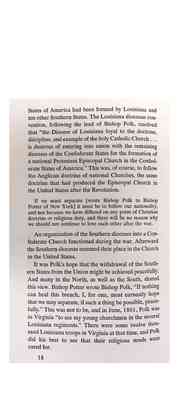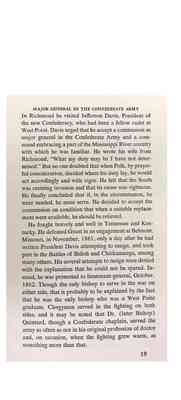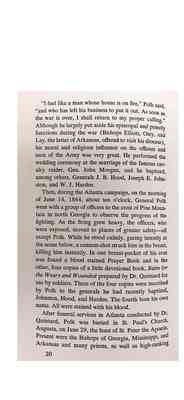Pages
21
later writing that he was amazed and delighted by Bishop Polk's "laborious and thoroughly digested projects for the southern university, which when completed was to the be the noblest and best-endowed in Christendom." To Bishop Polk he wrote:
The Lord has raised you up for the noblest work in you day and generation, and it is my earnest hope and daily prayer that you may be guided by His unerring wisdom to the full attainment of your most sanguine anticipation.
On October 9, 1860, the cornerstone of the University of the South was laid by Bishop Polk, as part of a solemn ceremony attended by several thousand spectators, the Bishop dedicating the University to "the cultivation of true religion, learning, and virtue, that thereby God may be glorified and the happiness of man may be advanced." In only four years since his original appeal, a great university domain had been obtained, a name chosen, a charter granted and a sum raised sufficient to begin construction for what was to be "a home of all the arts and sciences and of literary culture in the Southern States." And, although the funds were lost in the holocaust of civil war, the cornerstone blown up by Federal troops, yet the domain, the name, and the charter remained. On this foundation the present University of the South has risen. Appropriately enough, the emergence of the University after the war was largely the result of efforts by the Connecticut-born Bishop of Tennessee, sometime chaplain and surgeon in the Confederate Army, Charles Todd Quintard.
SECESSION COMES
The State of Louisiana seceded from the United States in January, 1861, and within a month the Confederate
17
22
States of America had been formed by Louisiana and ten other Southern States. The Louisiana diocesan convention, following the lead of Bishop Polk, resolved that "the Diocese of Louisiana loyal to the doctrine, discipline, and example of the holy Catholic Church... is desirous of entering into union with the remaining dioceses of the Confederate states for the formation of a national Protestant Episcopal Church in the Confederate States of America." This was, of course, to follow the Anglican doctrine of national Churches, the same doctrine that had produced the Episcopal Church in the United States after the Revolution.
If we must separate [wrote Bishop Polk to Bishop Potter of New York] it must be to follow our nationality, and not because we have differed on any point of Christian doctrine or religious duty, and there will be no reason why we should not continue to love each other after the war.
An organization of the Southern dioceses into a ConFederate Church functioned during the war. Afterward the Southern dioceses resumed their place in the Church in the United States.
It was Polk's hope that the withdrawal of the Southern States from the Union might be achieved peacefully. And many in the North, as well as the South, shared this view. Bishop Potter wrote Bishop Polk, "If nothing can heal the breach, I, for one, most earnestly hope that we may separate, if such a thing be possible, peacefully." This was not to be, and in June 1861, Polk was in Virginia "to see my young churchmen in the several Louisiana regiments." There were some twenty thousand Louisiana troops in Virginia at that time, and Polk did his best to see that their religious needs were cared for.
18
23
MAJOR GENERAL IN THE CONFEDERATE ARMY
In Richmond he visited Jefferson Davis, President of the new Confederacy, who had been a fellow cadet at West Point. Davis urged that he accept a commission as major general in the Confederate Army and a command embracing a part of the Mississippi River country with which he was familiar. He wrote his wife from Richmond, "What my duty may be I have not determined." But no one doubted that when Polk, by prayerful consideration, decided where his duty lay, he would act accordingly and with vigor. He felt that the South was resisting invasion and that its cause was righteous. He finally concluded that if, in the circumstances, he were needed, he must serve. He decided to accept the commission on condition that when a suitable replacement were available, he should be relieved.
He fought bravely and well in Tennessee and Kentucky. He defeated Grant in an engagement at Belmont, Missouri, in November, 1861, only a day after he had written President Davis attempting to resign, and took part in the Battles of Shiloh and Chickamauga, among many others. His several attempts to resign were denied with the explanation that he could not be spared. Instead, he was promoted to lieutenant-general, October, 1862. Though the only bishop to serve in the war on either side, that is probably to be explained by the fact that he was the only bishop who was a West Point graduate. Clergymen served in the fighting on both sides, and it may be noted that Dr. (later Bishop) Quintard, though a Confederate chaplain, served the army as often as not in his original profession of doctor and, on occasion, when the fighting grew warm, as something more than that.
19
24
"I feel like a man whose house is on fire," Polk said, "and who has left his business to put it out. As soon as the war is over, I shall return to my proper calling." Although he largely put aside his episcopal and priestly functions during the war (Bishops Elliott, Otey, and Lay, the latter of Arkansas, offered to visit his diocese), his moral and religious influence on the officers and men of the Army was very great. He performed the wedding ceremony at the marriage of the famous cavalry raider, Gen. John Morgan, and he baptized, among others, Generals J. B. Hood, Joseph E. Johnston, and W. J. Hardee.
Then, during the Atlanta campaign, on the morning of June 14, 1864, about ten o'clock, General Polk went with a group of officers to the crest of Pine Mountain in north Georgia to observe the progress of the fighting. As the firing grew heavy, the officers, who were exposed, moved to places of greater safety--all except Polk. While he stood calmly, gazing intently at the scene below, a cannon-shot struck him in the breast, killing him instantly. In one breast-pocket of his coat was found a blood stained Prayer Book and in the other, four copies of a little devotional book, "Balm for the Weary and Wounded" prepared by Dr. Quintard for use by soldiers. Three of four copies were inscribed by Polk to the generals he had recently baptized, Johnston, Hood, and Hardee. The fourth bore his own name. All were stained with his blood.
After funeral services in Atlanta conducted by Dr. Quintard, Polk was buried in St. Paul's Church, Augusta, on June 29, the feast of St. Peter the Apostle. Present were the Bishops of Georgia, Mississippi, and Arkansas and many priests, as well as high-ranking
20
25
civil and military leaders. His body (with that of his wife, who died in 1875) was reinterred in Christ Church Cathedral, New Orleans, in 1945, the sesquicentennial year of Anglicanism in Louisiana.
Of Polk as Bishop, his successor as diocesan, Joseph P. B. Wilmer, said:
No one in his office was ever more endeared to the people of his charge, and none have done more to deserve it.
For Further Reading
"Leonidas Polk, Bishop and General" by William M. Polk (New York. Longman, Green. 2 vols., revised edition, 1915.)
"So Great a Good: A History of the Episcopal Church in Louisiana and of Christ Church Cathedral, 18051955" by Hodding Carter and Betty Werlein Carter (Sewanee, University Press, 1955).
"The Church in the Confederate States" by Joseph Blount Cheshire (New York, Longmans, Green. 1912).
"History of the University of the South" by G. R. Fairbanks (Jacksonville, Drew 1905).




